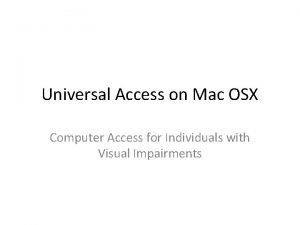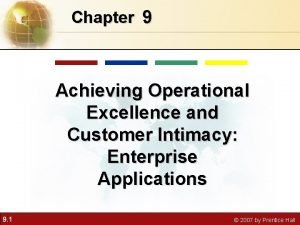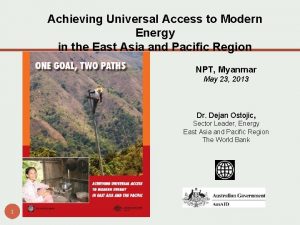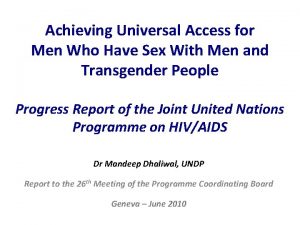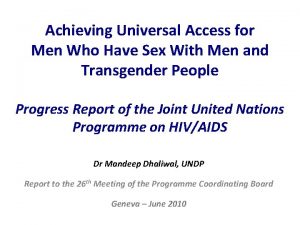Achieving universal access to and use of space










- Slides: 10

Achieving universal access to, and use of space applications for sustainable development in Asia and the Pacific Keran Wang Chief, Space Applications Section ICT and Disaster Risk Reduction Division

ESCAP’s EO services q Timely provision to countries affected by disasters: 400+ satellite images/products for drought, cyclone, earthquake and flood. q 7 X 24 service with free data and support from RESAP member countries, valued US$ 1 million+. q Enhancing institutional capacities of developing countries on effective use of space-derived data and GIS for disaster risk modelling, assessment and monitoring. q Developing knowledge products/tools for systematic use of geospatial data and strengthening operational early warning system. q In collaboration with Charter, UNOSAT, GEOSS, AOGEOS, Sentinel Asia, and UN-SPIDER.

Integrating geospatial dimensions with digital innovations • The Asia-Pacific region is rapidly evolving into a hub of innovation , advances in digital innovations include the Internet of things, artificial intelligence, big data, cloud computing, robotics and automation. • Space applications have significant potential to contribute to the SDGs in the following areas: Disaster risk reduction and resilience, natural resource management, connectivity, social development, energy and climate change.

Outcomes of the Ministerial Conference 1. Ministerial Declaration on space applications for sustainable development in Asia and the Pacific 2. Asia-Pacific Plan of Action on Space Applications for Sustainable Development (2018 -2030) Group photo of Heads of Delegation 10 October 2018 Bangkok, Thailand

Integrating Geospatial Dimensions for a Sustainable Asia-Pacific • • • 188 actions six thematic areas 14 Goals: where space applications can significantly contribute to global framework 37 Targets: as prioritized by the space community for the Asia-Pacific region

Goals and targets supported by the Po. A 6 priority themes Sum of targets for each priority theme Goals and targets Num Sendai Framework 1, 2, 3, 4 4 SDG 11. 5 1 SDG 2. 4 1 SDG 13. 1 1 SDG 6. 1, 6. 3, 6. 5, 6. 6 4 SDG 9. 4 1 SDG 11. 4, 11. 6, 11. b 3 SDG 12. 2 1 SDG 14. 1, 14. 2, 14. 4, 14. 5, 14. 7 5 SDG 15. 1, 15. 2, 15. 3, 15. 4, 15. 5 5 SDG 3. 6 1 SDG 4. b 1 SDG 9. c 1 SDG 10. 7 1 SDG 11. 2, 11. 3 2 SDG 1. 5 1 SDG 3. 9, 3. d 2 Energy SDG 7. b 1 1 Climate Change SDG 13. 2 1 1 Disaster Risk Reduction and Resilience Management of Natural Resources Connectivity Social Development Sum for 6 priority themes 7 19 6 3 37

Implementation modalities 1. Research and knowledge sharing 2. Capacity building and technical support 3. Intergovernmental discussions and regional practices ü Among the three, capacity building and technical support has been recommended by the ICC as a priority for most Asia. Pacific countries in implementing the plan of action ü Focus is on geospatial information applications

Review phases of the plan of action The Plan of Action will be reviewed periodically to reflect the evolving needs of countries, emerging technologies, shifting priorities and unforeseen challenges arising in the region. Phase 1 20182022 Phase 2 20222026 Phase 3 20262030 • As a result, a phased review has been suggested over 4 -year periods. • A biennial report will be published on new regional trends in digitally led innovations in geospatial information applications and services.

Means of implementation • An ongoing collective effort. • Strengthen the partnerships at the global and regional level: GEO, GEOGLAM, GEOSS, UNITAR/UNOSAT, UNOOSA, UNGGIM-AP, AOGEOS, CSSTEAP, APRSAF. • Leverages existing capacities in the region. • Primary responsibility of implementation is with governments on a voluntary basis, and tailored to country needs and development priorities. ESCAP will seek financial contributions and a Trust Fund is proposed to be established to support national and regional implementation.

Thanks….
 Mac universal access
Mac universal access Allows users to categorize and locate information
Allows users to categorize and locate information Trends in ict assistive media
Trends in ict assistive media Terminal access controller access control system plus
Terminal access controller access control system plus Terminal access controller access-control system
Terminal access controller access-control system Intentional use of unfriendly or offensive behavior
Intentional use of unfriendly or offensive behavior Chapter 3 achieving mental and emotional health
Chapter 3 achieving mental and emotional health Chapter 3 mental and emotional health answer key
Chapter 3 mental and emotional health answer key Achieving operational excellence and customer intimacy
Achieving operational excellence and customer intimacy Chapter 3 mental and emotional health answer key
Chapter 3 mental and emotional health answer key Chapter 3 achieving mental and emotional health
Chapter 3 achieving mental and emotional health
